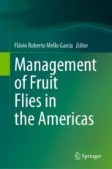Search
Search Results
-
Sex differences in a large herbivore’s salt water drinking behaviour: a method for applying a female-biased attractant
Female abundance, which is directly related to population dynamics through recruitment, is crucial for population management, and female culling is...

-
2-Pentylfuran: an aggregation attractant for wireworms
Wireworms (Coleoptera: Elateridae) are generalist insect pests that aggregate and feed on the roots of various crops, including maize. It remains...

-
Ulva as potential stimulant and attractant for a valuable sea urchin species: a chemosensory study
The green seaweed Ulva is close to becoming popular due to its suitability as potential feedstock production and for food items. However, there is a...

-
Identification of a Female-Produced Sex Attractant Pheromone of the Winter Firefly, Photinus corruscus Linnaeus (Coleoptera: Lampyridae)
Firefly flashes are well-known visual signals used by these insects to find, identify, and choose mates. However, many firefly species have lost the...

-
Identification of an adult attractant for Anomala corpulenta by the reverse chemical ecology approach
Semiochemicals are dominant cues for insects to locate food, mates, predators, and oviposition sites. In the modern genomic era, semiochemicals have...

-
Attractant Activity of Host-Related Chemical Blends on the Poultry Red Mite at Different Spatial Scales
Many blood-feeding arthropods use volatile organic compounds (VOCs) to detect their vertebrate hosts. The role of chemical interactions in mediating...

-
A Symmetrical Diester as the Sex Attractant Pheromone of the North American Click Beetle Parallelostethus attenuatus (Say) (Coleoptera: Elateridae)
Hexanoic acid, 1-octanol, 1,8-octanediol, octyl hexanoate, 1,8-octanediol monohexanoate, and 1,8-octanediol dihexanoate were identified in headspace...

-
White stork Ciconia ciconia nests as an attractant to birds and bats
White storks ( Ciconia ciconia ), an emblematic bird of high conservation interest, build massive nests which are also important breeding sites for...

-
Effectiveness of attractants and bait for Iberian wolf detection: captivity-based and free-ranging trials
Monitoring large carnivores requires substantial effort, which is why indirect methodologies such as camera trap** with attractants or baits are...

-
Contribution of ethyl β-d-glucoside, amino acids, and organic acids in tomato root exudates to the chemotaxis of Ralstonia pseudosolanacearum
Ralstonia pseudosolanacearum is attracted to tomato root exudates, but the extent to which the various components contribute to the attractant...

-
The Response of Susceptible and Pyrethroid-Resistant Blattella germanica (Dyctioptera: Blattellidae) to Shelter-Associated Cues
In this work, it was studied the role of faeces in the location and permanence in a shelter in susceptible and pyrethroid-resistant individuals of Blat...

-
Sex Attractant Pheromone of the Japanese Slave-Making Ant, Polyergus samurai
The objective of our project was to identify the sex attractant pheromone of queens of the slave-making ant Polyergus samurai , which was...

-
Pheromone chemistry of the Neotropical cerambycid beetles Achryson surinamum and Sphaerion inerme
During field screening trials in Brazil, adults of both sexes of the cerambycid beetle Achryson surinamum (L.) (Cerambycinae: Achrysonini) were...

-
Monitoring and Mass Trap** of Fruit Flies (Diptera: Tephritidae) in the Americas
Tephritid fly trap** methods for detecting, monitoring, and controlling these pests in the Americas have been studied extensively. These methods...
-
Origin, structure and functional transition of sex pheromone components in a false widow spider
Female web-building spiders disseminate pheromone from their webs that attracts mate-seeking males and deposit contact pheromone on their webs that...

-
Widow spiders alter web architecture and attractiveness in response to same-sex competition for prey and mates, and predation risk
Female-female competition in animals has rarely been studied. Responses of females that compete context-dependently for mates and prey, and seek...

-
Individual Variation in Male Pheromone Production in Xylocopa sonorina Correlates with size and Gland Color
Sex pheromones are species-specific chemical signals that facilitate the location, identification, and selection of mating partners. These pheromones...

-
Leaf waxes from Lathyrus sativus: short-range attractant and stimulant for nymph laying in a viviparous insect
Lathyrus sativus L. (Fabaceae) is an important pulse crop of Asia, Europe, and Africa. Infestation by the aphid, Aphis craccivora Koch (Hemiptera:...

-
Flower Visitor Assemblage and Foraging Profile of a Pollinator Attractant Non-crop Plant Isodon coetsa (Buch.-Ham. ex D.Don) Kudô from Eastern Himalayas, India
The functioning and upkeep of trophic chains in ecosystems, as well as the patterns and processes that shape biodiversity in the world, have all been...

-
Effects of dietary betaine supplementation on growth performance, feed intake, intestinal histology, lipid metabolism, and immune response of black tiger shrimp (Penaeus monodon) fed diets containing two levels of raw feed attractants
To assess the effects of dietary betaine supplementation on growth performance, feed intake, intestine histology, lipid metabolism, and immune...

